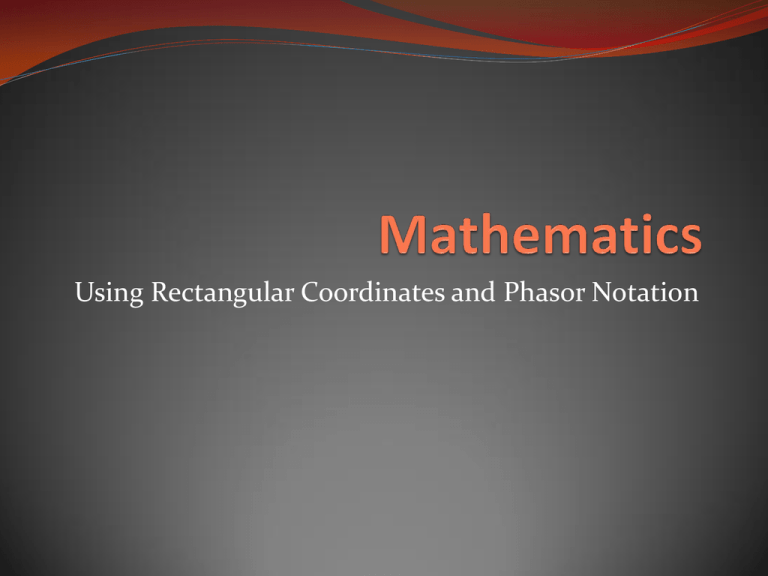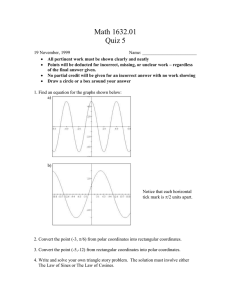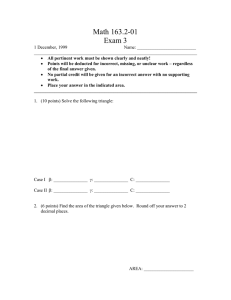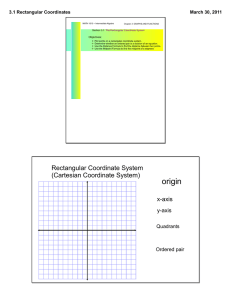Using Rectangular Coordinates and Phasor Notation
advertisement

Using Rectangular Coordinates and Phasor Notation
Addition and Subtraction
You can only add or subtract voltages with voltages, currents with
currents, impedances with impedances, and admittances with
admittances.
Addition with Rectangular Coordinates
If Z = X + Y and X = a + jb and Y = c + jd
Add the real component of the rectangular coordinate
(a + c).
Add the imaginary component of the rectangular
coordinate (b + d).
Combine the results into rectangular coordinates.
Z = (a + c) + j(b + d)
Re (Z) = (a + c) and Im(Z) = (b + d)
Subtraction with Rectangular Coordinates
If Z = X - Y and X = a + jb and Y = c + jd
Subtract the real component of the rectangular
coordinate (a - c).
Subtract the imaginary component of the rectangular
coordinate (b - d).
Combine the results into rectangular coordinates.
Z = (a - c) + j(b - d)
Re (Z) = (a - c) and Im(Z) = (b - d)
Multiplication with Rectangular Coordinates
If Z = XY and X = a + jb and Y = c + jd
Multiple the coefficients of the real components of the two
numbers together (a·c).
Multiple the coefficients of the imaginary components of the
two numbers together (b·d).
Multiple the coefficient of the real component of X with the
imaginary component of the Y (a·d).
Multiple the coefficient of the real component of Y with the
imaginary component of the X (c·b).
The product Z = [(a·c)-(b·d)] + j[(a·d)+(c·b)]
Re(Z) = [(a·c)-(b·d)] and Im(Z) = [(a·d)+(c·b)]
Division with Rectangular Coordinates
If Z = X/Y and X = a + jb and Y = c + jd
Square the real component of Y (c2).
Square the imaginary component of Y (d2).
Multiple the coefficient of the real component of X with the real
component of the Y (a·c).
Multiple the coefficient of the imaginary component of X the
imaginary component of the Y (b·d).
Multiple the coefficient of the real component of X with the
imaginary component of the Y (a·d).
Multiple the coefficient of the real component of Y with the
imaginary component of the X (c·b).
The quotient Z ={ [(a·c)-(b·d)] ∕[a²+c²]} +j{[(c·b)-(a·d)] ∕[a²+c²]}
Re(Z) = [(a·c)-(b·d)] ∕[a²+c²] and Im(Z) = [(c·b)-(a·d)] ∕[a²+c²]
Addition and Subtraction with Phasors
To add or subtract voltages, currents, impedances, or
admittances that are expressed in phasor notation, you
must convert the phasor into rectangular coordinates.
Add or subtract the real component of the rectangular
coordinate.
Add or subtract the imaginary component of the
rectangular coordinate.
Combine the results into rectangular coordinates.
Convert rectangular coordinates to phasor notation.
Multiplication and Division with Phasors
If V = vf and I = iq
To multiple or divide voltages, currents, impedances, or
admittances that are expressed in phasor notation,
Multiply or divide the magnitudes of the phasors.
The resulting phase angle is obtained by:
Add the phase angles together if the mathematical function is
multiplication
Subtract the phase angle associated with the divisor
(denominator) from the phase angle associated with the
dividend (numerator) if the mathematical function is division.
P = VI = vi (f+q) and Z = V/I = v/i (f-q)
Summary
Addition and subtraction of numbers expressed in
rectangular coordinates is straight-forward.
Multiplication and division of numbers expressed in
rectangular coordinates is more complex.
Some students prefer to convert the number into phasor
notation, perform the multiplication or division, and
then convert back to rectangular coordinates.
Multiplication and division with phasors is straight-
forward.
Addition and subtraction requires that the phasor be
rewritten in rectangular coordinates.


